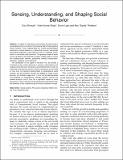Sensing, Understanding, and Shaping Social Behavior
Author(s)
Shmueli, Erez; Singh, Vivek; Lepri, Bruno; Pentland, Alex Paul
Downloadsensing_understanding_shaping.pdf (1.098Mb)
OPEN_ACCESS_POLICY
Open Access Policy
Creative Commons Attribution-Noncommercial-Share Alike
Terms of use
Metadata
Show full item recordAbstract
The ability to understand social systems through the aid of computational tools is central to the emerging field of computational social systems. Such understanding can answer epistemological questions on human behavior in a data-driven manner, and provide prescriptive guidelines for persuading humans to undertake certain actions in real-world social scenarios. The growing number of works in this subfield has the potential to impact multiple walks of human life including health, wellness, productivity, mobility, transportation, education, shopping, and sustenance. The contribution of this paper is twofold. First, we provide a functional survey of recent advances in sensing, understanding, and shaping human behavior, focusing on real-world behavior of users as measured using passive sensors. Second, we present a case study on how trust, which is an important building block of computational social systems, can be quantified, sensed, and applied to shape human behavior. Our findings suggest that:1) trust can be operationalized and predicted via computational methods (passive sensing and network analysis) and 2) trust has a significant impact on social persuasion; in fact, it was found to be significantly more effective than the closeness of ties in determining the amount of behavior change.
Date issued
2014-06Department
Massachusetts Institute of Technology. Department of Materials Science and EngineeringJournal
IEEE Transactions on Computational Social Systems
Publisher
Institute of Electrical and Electronics Engineers (IEEE)
Citation
Shmueli, Erez, Vivek K. Singh, Bruno Lepri, and Alex Pentland. “Sensing, Understanding, and Shaping Social Behavior.” IEEE Transactions on Computational Social Systems 1, no. 1 (March 2014): 22–34.
Version: Author's final manuscript
ISSN
2329-924X